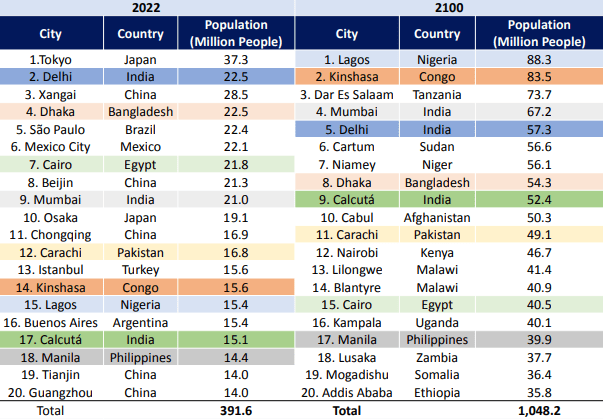Lagos (Nigeria), Kinshasa (Congo) and Dar Es Salaam (Tanzania) will be the world’s largest cities in 2100, according to projections by the Global Cities Institute.
This is the ranking, measured in millions of inhabitants:
- Lagos, Nigeria: 88.3
- Kinshasa, Congo: 83.5
- Dar Es Salaam, Tanzania: 73.7
- Mumbai, India: 67.2
- Delhi, India: 57.3
- Khartoum, Sudan: 56.6
- Niamey, Niger: 56.1
- Dhaka, Bangladesh: 54.3
- Calcutta, India: 52.4
- Kabul, Afghanistan: 50.3
- Karachi, Pakistan: 49.1
- Nairobi, Kenya: 46.7
- Lilongwe, Malawi: 41.4
- Blantyre, Malawi: 40.9
- Cairo, Egypt: 40.5
- Kampala, Uganda: 40.1
- Manila, Philippines: 39.9
- Lusaka, Zambia: 37.7
- Mogadishu, Somalia: 36.4
- Addis Ababa, Ethiopia: 35.8
Largest cities in the world
The latest United Nations (UN) projections suggest that the world’s population could grow to around 8.5 billion by 2030, 9.7 billion by 2050 and 10.4 billion by 2100.
According to the UN, the global population is likely to peak during this century. It is expected to continue growing for the next fifty to sixty years.

By the mid-2080s, it could reach around 10.3 billion people, compared to 8.2 billion in 2024.
Then, the population is expected to begin to decline gradually, reaching 10.2 billion by the end of the century.
The probability that the global population will peak this century is very high, with an estimated 80 percent.
Fertility
This change is significant compared to the United Nations projections of 10 years ago.
At that time, global population growth was estimated to end in the 21st century with a probability of about 30 percent.
Now, the population in 2100 is estimated to be 6 percent lower (about 700 million fewer people) than previously projected.
This early anticipation of the population peak is due to several factors, including lower fertility levels than expected in recent years, especially in some of the largest countries, such as China.

